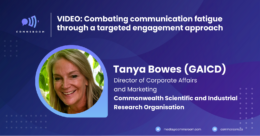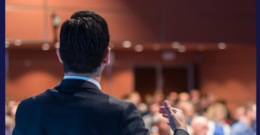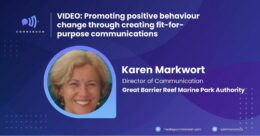Corporate communications have definitely changed in the past few years, with COVID-19 making remote work more mainstream, and artificial intelligence (AI) tools such as Google‘s Bard changing the way we process and generate content in various ways.
For this week’s Featured Leader, we talk to Katrin Maurer, Google’s Director of Communications for Australia and New Zealand. Before Google, Katrin also worked in various corporate communications roles at companies like GroupOn China and Audi.
For this interview, Katrin gave us a brief overview into her work, and how she uses Bard, Google’s very own AI-powered conversational chat service to do her job both better and easier.
You’ve had quite a career in corporate communications, even before landing a job at Google. What got you on this journey?
I’ve always loved stories and storytelling. Growing up in rural Germany, one of my favourite places to be was the public library. Several times per week, I would carry a backpack full of books back and forth between the library and our house, and you’d often find me curled up with a book somewhere in the garden.
That love for storytelling has stayed with me and during uni, when I was looking for an internship, I ended up doing my first stint with a PR agency – and it immediately felt like coming home. I just loved the intersection of creativity and strategic thinking that corporate communications brings. Over the years, I’ve done a number of different roles, some in areas like corporate strategy and business planning, but I always kept coming back to communications. For me, it’s such a fascinating field as it allows you to combine the art of storytelling, with the science of understanding your audience and tailoring a story, or message, or campaign to that audience.
What is a typical workday for the Director of Communications in Australia and New Zealand?
What makes this job so interesting is that there are rarely two days that are the same. My team covers internal and external communications for all of Google’s products, services, and programs, and there’s always something new to learn.
As the team lead, I’m helping my team prepare strategies for key announcements and issues. For instance, a few weeks ago, we announced an update to a Google partnership with the WWF to monitor endangered Australian wildlife with AI. For me, it’s really important that we consider 360 degree communications with any milestone – and that means supporting the team with the usual launch assets for the media announcement but also looking at all the other ways we could amplify the news. That could include partnering with our marketing and social teams who work on our own channels, making sure Googlers hear about it at internal events, or experimenting with other ways to get the message out.
In addition to the announcement of the day, there’s usually an opportunity to catch up with our team, whether that’s in 1:1 meetings, for lunch in one of the cafes, or just being there to listen and support them with the tasks at hand – from handling media inquiries to finalising written materials.
More so than at other places I’ve worked, open collaboration is a key part of Google’s culture. That’s why cross-functional work makes up a big part of my day, too. That means providing strategic counsel to the business, participating in leadership discussion about next steps for local programs like our Digital Future Initiative, or conducting risk assessment and mitigation across a range of issues.
While the work is often fast-paced, I make it a point to always take an hour for myself at some point during the day – and I encourage my team to do the same. Whether that’s stepping away for an hour to do a yoga or pilates class, or starting the day a bit later to get a morning swim in, it just helps me be much more present and energised at work.
What’s your favourite thing about your job at Google?
The people who work at Google, paired with the opportunity to work on incredibly interesting and impactful topics. This is what initially drew me to Google and was and has kept me there for 9 years. Google employees are smart, they care deeply and are always ready to help each other. To be able to work in such an environment and have the chance to help communicate new tools used by billions of people or projects that have a significant, positive impact on people’s lives is pretty unique and inspiring.
What’s the most challenging aspect of what you do?
As communicators, we know how important it is to focus on a few, clear messages. Given the breadth of topics you could cover at Google on any given day, the discipline to really focus on a few key things and avoid getting side-tracked is top of mind for me. I’m a big believer in fitting work within your life overall and not the other way around – and in a field like communications for an industry that is so fast-paced, this is only possible if you’re clear about your focus.
New artificial intelligence tools are emerging daily, and many thought leaders have made their thoughts known, with some having a gloomier prediction than others. As for you, how will AI tools like Bard shape the future? How is AI going to shape corporate communications, specifically?
I’ve long been inspired by people in all kinds of fields using AI as a tool to solve problems, whether it’s doctors detecting diseases with AI or conservationists monitoring endangered species. As a communications professional, I’ve been using Bard, Google’s experiment for conversational AI, to help with ideas for a number of tasks. For instance, when I’m writing a media release, I might ask Bard to generate five ideas for headlines. While I won’t copy and paste what I get back, I use the responses as a thought starter to help me write. It’s also been a helpful tool to create outlines for longer pieces of content or pull together a multi-week launch plan.
Our Managing Director in Australia, Mel Silva, often talks about the need to focus on the questions, not the technology. This applies to this question, too. As communicators, we need to know what the key problems are we’re trying to solve and gather the key questions we need to answer – and then make an assessment about how we can solve them. In some cases, AI might be part of the solution, while other challenges can be tackled very differently.
While this is an exciting technology, it’s still very new – I believe there will be lots of ways we will use these tools to be creative, tackle tasks at work, and solve problems that we can’t even imagine just yet. We just need to start with the questions first.
What do you think about recent efforts made by governments to regulate AI?
As Google’s CEO Sundar Pichai has been saying for a few years, AI needs to be regulated – it’s too important not to. There are incredible opportunities with AI but also risks, that’s why Google’s approach is to be bold and responsible.
That means developing AI in a way that maximises the positive benefits to society while addressing the challenges, guided by our AI Principles. Our teams here in Australia and around the world strive to be helpful partners to regulators, offering expertise, experience and tools as we all navigate these issues together.
Post Views: 64




























